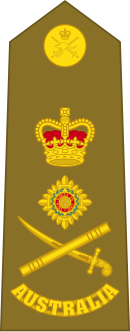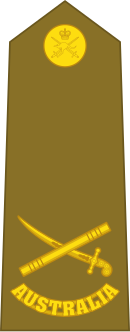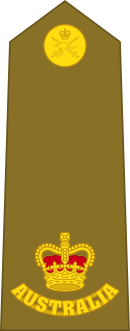Australian Army officers receive a commission from the Governor-General of Australia, who is also the Commander-in-Chief of the Australian Defence Force. The commission is signed by both the Governor-General and the Minister of Defence. Rank insignia for commissioned officers is identical to that of the British Army, with the addition of a band containing the word "Australia" beneath the insignia.
Ranks and rank grades
Officer ranks in the Australian Army are organised into grades for administrative and promotional purposes. The rank grades also give an indication of what that particular officer's role or position may be, although 'rank grade' is not an official term. The ranks are organised below from highest to lowest:
Appointed Officer ranks
- Governor General of Australia. This rank is the highest appointed rank in the Australian Army, and is its Commander-in-Chief.
- State Governor. This rank insignia is worn by state governors.
- Field Marshal (Abbreviated: FM) – O11. This rank is generally reserved for wartime and ceremonial purposes; there are no regular appointments to the rank. Four people have been promoted to this rank in the Australian Army: Sir Thomas Blamey; Lord Birdwood; Prince Philip, Duke of Edinburgh; and King Charles III.
General Officer ranks
- General (Abbreviated: GEN) – O10. Since the end of the Second World War, this rank has only been held when an Army officer is appointed as Chief of the Defence Force.
- Lieutenant General (Abbreviated: LTGEN) – O9. Held by Chief of Army and, when Army officers are appointed to the Joint positions, Vice Chief of the Defence Force, Chief of Joint Operations and Chief of Capability Development.
- Major General (Abbreviated: MAJGEN) – O8.
Senior Officer ranks
- Brigadier (Abbreviated: BRIG) – O7. Like the United Kingdom, prior to 1922 Australia used the rank Brigadier General.
- Colonel (Abbreviated: COL) – O6.
Field Grade Officer ranks
- Lieutenant Colonel (Abbreviated: LTCOL) – O5.
- Major (Abbreviated: MAJ) – O4.
Company Grade Officer ranks
- Captain (Abbreviated: CAPT) – O3.
- Lieutenant (Abbreviated: LT) – O2.
- Second Lieutenant (Abbreviated: 2LT) – O1.
The rank of second lieutenant has been phased out of the Australian Army, with officer recruits now graduating from the Royal Military College, Duntroon with the rank of lieutenant.
Officer Trainee rank
- Staff Cadet (Abbreviated SCDT)
- Officer Cadet (Abbreviated: OCDT)
Cadet rank insignia
SCDT and OCDT are equivalent rank titles. The rank of Officer Cadet is given to those who are studying at the Australian Defence Force Academy. Their rank is then changed to Staff Cadet upon entry to the Royal Military College, Duntroon (RMC-D) where they become a part of the Corps of Staff Cadets. Officer cadets wear a 10mm wide white stripe, on a DPCU slide or hard shoulder board, as their rank insignia. Officer Trainees in University Regiments undergoing Army Reserve Officer Training have also been known as Officer Cadets as of November, 2009. Previous to this they administratively belonged to RMC-D and were known as Staff Cadets. Staff Cadets are presently only full-time RMC-D officer trainees. Staff Cadets wear "RMC" on their rank slides in order to distinguish them from other training establishments.
Officer rank insignia of the Australian Army
The insignia worn by officers in the Australian Army use three symbols which are also used in the insignia of the British Army:
- The Star, commonly called a pip, is derived from the Star of the Knight Grand Cross of the Military Division of the Most Honourable Order of the Bath.
- The Crown has varied in the past, with the Tudor Crown being used from 1910 until 1953, when it was replaced by the St Edward's Crown from the coronation of Elizabeth II.
- The Crossed Sword and Baton has been in use by generals of the British Army since at least 1800.
Insignia
| Appointed Ranks of the Australian Army | ||
|---|---|---|
| Governor-General of Australia |
State Governor |
Field Marshal (FM) |
 |
 |
 |
| General Ranks of the Australian Army | Abolished General Ranks | |||
|---|---|---|---|---|
| General (GEN) |
Lieutenant General (LTGEN) |
Major General (MAJGEN) |
Brigadier General (abolished 1921) | |

|

|

|

| |
| Senior Officer Ranks of the Australian Army | Field Grade Officer Ranks of the Australian Army | ||
|---|---|---|---|
| Brigadier (BRIG) (since 1928) |
Colonel (COL) |
Lieutenant Colonel (LTCOL) |
Major (MAJ) |

|

|

|

|
- ^ An Australian brigadier is not considered as a "general", but rather a senior colonel or field officer.
In 1921 the British Army replaced the rank of brigadier-general with both Colonel-Commandant and Colonel-of-the-Staff depending on the appointment. These ranks were given the rank insignia of a Crown and three stars (pips). After issues with those ranks arose, particularly the loss of precedent and respect and prestige being equated to a colonel, in 1928 the rank brigadier was introduced and replaced Colonel-Commandant and Colonel-of-the-Staff but retained the same rank insignia to reflect that a brigadier is a senior colonel and field officer, and not a junior general. The Australian Imperial force followed the same order to abolish the brigadier-general rank effective 1 January 1921, and the Australian army followed the same rank structure once efforts to establish a regular infantry force in 1938.
| Company Grade Officer Ranks of the Australian Army | ||
|---|---|---|
| Captain (CAPT) |
Lieutenant (LT) |
Second Lieutenant (2LT) |

|

|

|
| Officer Cadet/Officer Trainee Ranks of the Australian Army | |
|---|---|
| Officer Cadet (OCDT) |
Staff Cadet (SCDT) |

|

|
See also
- Australian Army enlisted rank insignia
- Australian Defence Force ranks
- List of Australian generals and brigadiers
- Uniforms of the Australian Army
References and notes
- Commonwealth of Australia Gazette extract A.A.O 33, 1926, Notice No2 of 14 January 1926
- Australian Army Gradation List of Officers
- "Australian Defence Force Honorary Ranks for His Majesty The King". defence.gov.au. 2024-10-19. Retrieved 2024-10-25.
- An Australian brigadier is not classed as a "general", whereas an Australian brigadier general was. The British Army replaced the rank of brigadier general with colonel-commandant in 1922, and then with brigadier in 1928. The rank insignia was changed from crossed sabre and baton to crown with three stars ("pips") to reflect that a brigadier is a senior colonel rather than a junior general. The Australian Army did something similar.
- ^ In the Australian Army, Lieutenant is pronounced "Lef-tenant"
- "Commissioned Officer Ranks". Australian Army. Archived from the original on 2016-08-08. Retrieved 18 August 2016.
- "General Service Officer". Defence Jobs. Defence Force Recruiting. Archived from the original on 27 August 2016. Retrieved 18 August 2016.
- Army Standing Orders on Dress (ASOD) vol 2, part 4, ch 3.19, May 2002.
- Jobson, Christopher (2009). Looking Forward, Looking Back: Customs and Traditions of the Australian Army. Wavell Heights, Queensland: Big Sky Publishing. ISBN 9780980325164.
- "Chapter 4: Badges and Emblems" (PDF). Army Dress Manual. Canberra: Australian Army. 6 June 2014. p. 4H1–1. Archived from the original (PDF) on 3 April 2015.
- "Chapter 4: Badges and Emblems" (PDF). Army Dress Manual. Canberra: Australian Army. 6 June 2014. p. 4H1–1. Archived from the original (PDF) on 3 April 2015.
- There are no regular appointments to the rank of Field Marshal.
- Australian Field Marshal rank insignia is similar to the British insignia, although there is a small difference. In the Australian insignia, the Crown is 5mm above the Crossed Batons. In the British insignia, the Crown is attached to the Crossed Batons.
- Neave-Hill, W. B. R. (1969). "The Rank Titles of Brigadier and Brigadier-General". Journal of the Society for Army Historical Research. 47 (190): 96–116. ISSN 0037-9700.
- ^ For the ranks of 2LT to LTCOL, unless posted overseas, the gilt "AUSTRALIA" at the base of the ceremonial hardboard rank slide (shown above) is replaced with gilt or silver Corps or Regimental shoulder titles. On cloth rank slides and on Service Dress and Mess Dress jackets the word "AUSTRALIA" is used by all officers regardless of rank.
- ^ The SCDT insignia is the same as OCDT, but with "RMC" at bottom instead of a thick white stripe.
External links
| Military ranks and insignia by country | |||||||||||
|---|---|---|---|---|---|---|---|---|---|---|---|
| Africa |
| ||||||||||
| Americas |
| ||||||||||
| Asia |
| ||||||||||
| Europe |
| ||||||||||
| Oceania |
| ||||||||||
| Language |
| ||||||||||
| Post-Soviet states | |||||||||||
| Commonwealth of Nations | |||||||||||
| European Union | |||||||||||
| NATO | |||||||||||
| Comparative ranks of | |||||||||||
